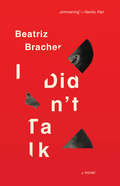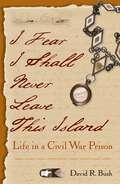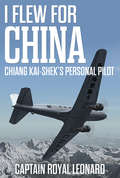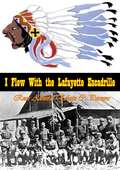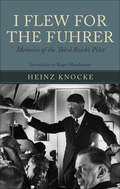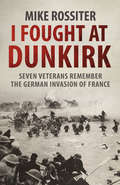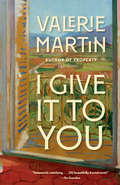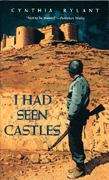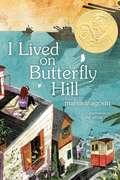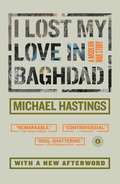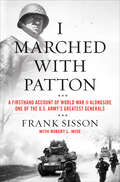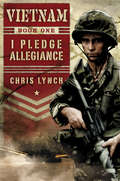- Table View
- List View
I Didn't Talk
by Adam Morris Beatriz BracherThe English-language debut of a master stylist: a compassionate but relentless novel about the long, dark harvest of Brazil’s totalitarian rule A professor prepares to retire—Gustavo is set to move from Sao Paulo to the countryside, but it isn’t the urban violence he’s fleeing: what he fears most is the violence of his memory. But as he sorts out his papers, the ghosts arrive in full force. He was arrested in 1970 with his brother-in-law Armando: both were vicariously tortured. He was eventually released; Armando was killed. No one is certain that he didn’t turn traitor: I didn’t talk, he tells himself, yet guilt is his lifelong harvest. I Didn’t Talk pits everyone against the protagonist—especially his own brother. The torture never ends, despite his bones having healed and his teeth having been replaced. And to make matters worse, certain details from his shattered memory don’t quite add up... Beatriz Bracher depicts a life where the temperature is lower, there is no music, and much is out of view. I Didn't Talk's pariah’s-eye-view of the forgotten “small” victims powerfully bears witness to their “internal exile.” I didn’t talk, Gustavo tells himself; and as Bracher honors his endless pain, what burns this tour de force so indelibly in the reader’s mind is her intensely controlled voice.
I Dread the Thought of the Place: The Battle Of Antietam And The End Of The Maryland Campaign
by D. Scott HartwigI Dream Of The Day - Letters From Caleb Milne - Africa, 1942-1943 [Illustrated Edition]
by Caleb MilneIncludes the War in North Africa Illustration Pack - 112 photos/illustrations and 21 maps.These are the letters Caleb Milne wrote to his mother while in the American Field Service.In May of 1943, he, with a small group of American Field Service men, responded to a call for volunteers to help the French. These Fighting French, under General Leclerc, had joined General Montgomery's 8th Army after that epic march from Lake Chad in Central Africa to Tunisia. Early the morning of May 11th, Caleb Milne was giving aid to a wounded Legionnaire when he was struck by a mortar shell. His wounds proved fatal and he died around 4:30 that afternoon.These letters, though very personal, are published with the thought that their message might reach beyond one mother. As Marjorie Kinnan Rawlings has said in her introduction:"This collection of his letters seems to me of permanent value, far beyond their satisfying of our avidity for news of the working of the minds of men who are fighting, for us, our battle. They reveal a rare soul, who passes on to us his own sensitive perceptions of the beauty and glory of living; and they are written in the style of true Belles-Lettres."In tribute to Caleb Milne, who wrote to him on the meaning of music to a soldier, Deems Taylor, noted author and composer, said:"This, to me, is one of the most deeply felt and profoundly moving communications that the war has yet inspired. It is one of the war's major tragedies that young men capable of such vision, self-abnegation, and compassion could not be spared to help shape the peace that, God willing, will be as nearly permanent as men of good will can make it."
I Escape!
by J. L. HardyThe true story of Major Hardy's numerous escapes from German prisoner of war camps during the First World War, with a foreword by Sir Arthur Conan Doyle“Major Jocelyn Lee "Hoppy" Hardy DSO, MC with Bar, (10 June 1894 – 30 May 1958) was a British Army officer famed in Britain for his courage on the battlefield and repeated escapes from German prisoner of war camps during the First World War. Between 1920 and 1922 he served in Dublin as part of the British counter-insurgency against republican forces during the Irish War of Independence and is considered one of the most ruthless and effective British intelligence officers combating the IRA who subsequently accused him of brutality. He retired from the army to become a successful writer. His nickname, "Hoppy", stemmed from the loss of a leg in combat during the final months of World War One. Fitted with a prosthesis, he trained himself to disguise the fact, by walking at a very quick pace, almost completely disguising the fact that he had a wooden leg.”-Wiki
I Escape!: The Great War's Most Remarkable POW
by J. L. HardyOf all the daring PoW escape stories that have come to light in the last 100 years and immortalized by Steve McQueen in the film The Great Escape, the story of J.L. Hardy has to be one of the most remarkable. A PoW for three-and-a-half years, Hardy made no less than twelve escape attempts while imprisoned by the Germans in the First World War, five of which being successful.In early 1915 he attempted to escape from Halle Camp, near Leipzig, by breaking through a brick wall into an adjacent ammunition factory. After five-months work the project proved impracticable. In the summer of 1915 he was transferred to Augustabad Camp, near Neu Brandenburg, and after being there 10 days he managed to slip away from a bathing party outside the camp, together with a Russian officer. After a difficult journey they covered the 50 miles to the Baltic coast. They swam a river, were nearly recaptured once, but eventually reached Stralsund. They nearly managed to get the crew of a Swedish schooner there to give them passage, but were arrested at the last moment.Hardy was returned to Halle and joined an unsuccessful attempt with a group of Russian officers to break down a wall. He then made a solo escape attempt by picking locks and breaking through a skylight before sliding down a rope onto the street. From here he slipped into the rain and darkness. He spoke enough German to make his way by train to Bremen. Here, broken down by cold and hunger, the Germans recaptured him.He was then transferred to Magdeburg, where he escaped with a Belgian officer using "subterfuge, audacity and good fortune". They reached Berlin by train, and went on to Stralsund. From there they crossed to the island of Rugen, but were arrested before they could find a fishing boat to take them to Sweden. His next prisoner of war camp was Fort Zorndorf, from where escape was virtually impossible. Nevertheless he made several attempts, and one nearly succeeded when, with two others, he almost got out disguised as a German soldier.Hardy was transferred around further and made subsequent escape attempts until he finally managed to escape for good in March 1918, after being a PoW for over three-and-a-half years.Written in Hardy's own words, this book reads like a wartime thriller or Hollywood screenplay and his Great War story makes for fascinating reading.
I Escaped from Auschwitz: The Shocking True Story of the World War II Hero Who Escaped the Nazis and Helped Save Over 200,000 Jews
by Rudolf VrbaThe Stunning and Emotional Autobiography of an Auschwitz Survivor April 7, 1944—This date marks the successful escape of two Slovak prisoners from one of the most heavily-guarded and notorious concentration camps of Nazi Germany. The escapees, Rudolf Vrba and Alfred Wetzler, fled over one hundred miles to be the first to give the graphic and detailed descriptions of the atrocities of Auschwitz. Originally published in the early 1960s, I Escaped from Auschwitz is the striking autobiography of none other than Rudolf Vrba himself. Vrba details his life leading up to, during, and after his escape from his 21-month internment in Auschwitz. Vrba and Wetzler manage to evade Nazi authorities looking for them and make contact with the Jewish council in Zilina, Slovakia, informing them about the truth of the &“unknown destination&” of Jewish deportees all across Europe. This first-hand report alerted Western authorities, such as Pope Pius XII, Winston Churchill, and Franklin D. Roosevelt, to the reality of Nazi annihilation camps—information that until then had only been recognized as nasty rumors.I Escaped from Auschwitz is a close-up look at the horror faced by the Jewish people in Auschwitz and across Europe during World War II. This newly edited translation of Vrba&’s memoir will leave readers reeling at the terrors faced by those during the Holocaust. Despite the profound emotions brought about by this narrative, readers will also find an astounding story of heroism and courage in the face of seemingly hopeless circumstances.
I Fear I Shall Never Leave This Island: Life in a Civil War Prison
by David R. BushJohnson's Island, in Sandusky, Ohio, was not the largest Civil War prison in the North, but it was the only one to house Confederate officers almost exclusively. As a result, a distinctive prison culture developed, in part because of the educational background and access to money enjoyed by these prisoners.David Bush has spent more than two decades leading archaeological investigations at the prison site. In I Fear I Shall Never Leave This Island he pairs the expertise gained there with a deep reading of extant letters between one officer and his wife in Alexandria, Virginia, providing unique insights into the trials and tribulations of captivity as actually experienced by the men imprisoned at Johnson's Island. Together, these letters and the material culture unearthed at the site capture in compelling detail the physical challenges and emotional toll of prison life for POWs and their families. They also offer fascinating insights into the daily lives of the prisoners by revealing the very active manufacture of POW craft jewelry, especially rings.No other collection of Civil War letters offers such a rich context; no other archaeological investigation of Civil War prisons provides such a human story.
I Flew For China
by Royal LeonardI Flew For China, first published in 1942, is the first narrative of an American's experiences flying in China at the time of the Japanese invasion of China and during the conflict between Communist and Nationalist forces. Beginning in 1935, author Royal Leonard (1905-1962) flew first Chang Hsueh-Liang, a Chinese warlord, then Chiang Kai-shek, leader of the Chinese Nationalists. During his 6 years in China, Leonard recounts his many adventures and provides his recommendations – given to General MacArthur – for preparing for the looming Japanese-American conflict of World War II.
I Flew For The Führer: The Story Of A German Fighter Pilot [Illustrated Edition]
by General Pete Quesada Heinz KnokeIncludes the Aerial Warfare In Europe During World War II illustrations pack with over 180 maps, plans, and photos.Heinz Knoke was one of Nazi Germany’s outstanding pilots, and this dramatic record of his experiences, illustrated with personal photos, has become a classic among aviation memoirs. He joined the Luftwaffe at the outbreak of the war, rose to the rank of commanding officer, and received the Knight’s Cross. Knoke’s account crackles with vivid accounts of air battles; and captures his utter desolation at Germany’s defeat.—Print Ed.
I Flew With the Lafayette Escadrille
by Lt.-Col. Kimbrough S. Brown Rear Admiral Edwin C. ParsonsEarly in 1916, a year before the United States entered World War I, a handful of valiant Americans banded together as the Lafayette Escadrille to forge their mark in history in the skies over France. Be it for fame, adventure or patriotism, they stepped forward to meet the common enemy long before their own nation realized the true extent of the threat to world freedom.During their days with the Escadrille, some of these men met death, while others lived out the war; but each, in his own way, earned immortality for himself and the Escadrille. As long as there remains a man with a love for flying in his heart, or one who has experienced the indescribable thrill of passing along through the tranquil solitude of the firmament, the memory of the Lafayette Escadrille and of those who served it so nobly will endure.This is the chronicle of an elite group of men, written by one of their own who survived the holocaust. The vivid account of battles in the air, the flush of success over a fallen foe, the sorrow from the loss of a comrade--all of these carry the reader back across the decades to that exciting period of so long ago.In essence, one does not read this book--he lives it.
I Flew for the Fuhrer
by Heinz KnockeHeinz Knoke was one of the outstanding German fighter pilots of World War II and this vivid first-hand record of his experiences has become a classic among aviation memoirs, a best-selling counter-balance to the numerous accounts written by Allied pilots.Knoke joined the Luftwaffe on the outbreak of war, and eventually became commanding officer of a fighter wing. An outstandingly brave and skillful fighter, he logged over two thousand flights, and shot down fifty-two enemy aircraft. He had flown over four hundred operational missions before being crippled by wounds in an astonishing 'last stand' towards the end of the war. He was awarded the Knight's Cross for his achievements. In a text that reveals his intense patriotism and discipline, he describes being brought up in the strict Prussian tradition, the impact of the coming of the Nazi regime, and his own wartime career set against a fascinating study of everyday life in the Luftwaffe, and of the high morale of the force until its disintegration.In a postscript provided for this edition, Heinz Knoke writes of the struggle to survive after the war in Germany, and his building of a new life. Now that the Berlin Wall has been torn down, his memoirs are set in a new perspective, both a valuable contribution to aviation literature and a moving human story.
I Fought at Dunkirk: Seven Veterans Remember Their Fight For Salvation
by Mike RossiterSURVIVOR STORIES FROM DUNKIRK, NOW THE SUBJECT OF A MAJOR FILM FROM CHRISTOPHER NOLANWhen Britain declared war against Germany in September 1939, thousands of young men sailed across the English Channel to fight for their country. Among them were the seven soldiers who share their stories in this book. Some joined up out of patriotism, others for adventure or the prospect of a secure wage. They were fit, trained and proud to wear the armband of the British Expeditionary Forces. For many, the first months were strangely peaceful, but when the Germans invaded in May 1940 they advanced with shocking speed. The German armoured columns sliced through neutral Holland and Belgium. The French Army collapsed and within a week the soldiers of the BEF were forced to retreat. Fighting tough and bloody rearguard actions, they endured relentless shelling and fearsome dive-bomb attacks. Constantly on the move, and facing a German onslaught on three fronts, they were soon exhausted, hungry and low on ammunition. They headed finally to their one chance of salvation: the beaches of Dunkirk. Mike Rossiter tells the stories of seven veterans who went through a hellish baptism of fire in the first battles on the front line, and fought in the last-ditch defence of Dunkirk. They saw their comrades bombed and drowned off the beaches. Their accounts give us a fascinating and privileged insight into the reality of the war and what it was really like to face the German Blitzkrieg in 1940. They take us from the confident, idyllic days of the phoney war in the French countryside to the sudden shock of battle, from the fear and confusion of retreat to the wait for an uncertain rescue. These are the compelling stories of seven men who are proud to say I Fought at Dunkirk.
I Give It to You: A Novel
by Valerie MartinA timeless story of family, war, art, and betrayal set around an ancient, ancestral home in the Tuscan countryside from bestselling novelist Valerie Martin.When Jan, an American academic, rents an apartment in a Tuscan villa for the summer, she plans to spend her break writing a biography of Mussolini. Instead, she finds herself captivated by her hostess, the elegant, acerbic Beatrice. Beatrice's family ties to Villa Chiara and the land on which it stands extend back generations, although the family has fallen on hard times since WWII and the fate of the property is uncertain. But it is rich in stories, and Jan becomes intrigued by an account of Beatrice's uncle, who was mysteriously killed on the grounds at the conclusion of the war. Did he die at the hands of the invading Americans, or was he murdered by his countrymen for his political opinions? Beatrice, a student of American literature, proves to be a beguiling storyteller and a sharp critic; she and Jan keep in touch after that summer, and a fierce friendship forms. As the years go on, Jan finds she can't help but write Beatrice's story, a decision that opens up questions of ownership and loyalty and leads to a major betrayal. Thrumming with tension, informed by history, and exploring themes of duty, destiny, art, and friendship, I Give It to You is Valerie Martin at the top of her game.
I Had Seen Castles
by Cynthia RylantJohn Dante is seventeen when the Japanese bomb Pearl Harbor, and he wants to fight for his country. Then he falls in love with Ginny Burton, who is against all war, and his beliefs are suddenly and unexpectedly questioned. But rather than be judged a traitor or a coward, he enlists. Rylant's story is heartbreaking in its honesty; her controlled, elegant prose lends poignancy to the story's emotional depth. A love story, a coming-of-age tale, a book with a passionate anti-war message, I Had Seen Castles is not to be missed.--Publishers Weekly
I Hate Martin Amis et al.
by Peter BarryThis is a novel quite unlike any other: even the most avid reader will find it original and unforgettable. It has the power to shock, disgust, and appall at the same time that it amuses, intrigues, and evokes sympathy, even empathy, for its monstrous central character, an anti-hero whose frustration at not being able to publish a novel fuels his descent into a very real moral abyss. "I Hate Martin Amis et al." provides a unique perspective on one of the worst war crimes of the modern age: the siege of Sarajevo seen through the eyes of a would be author and sniper killing innocent civilians just so he can write a novel about his experience.
I Have Your Back: How an American Soldier Became an International Hero
by Tom SileoThe story of U.S. Army Staff Sgt. Michael Ollis, who became an international hero for his courage and selflessness.Ever since he was a young boy growing up on the streets of Staten Island, New York, Michael Ollis wanted to be a soldier. Inspired by his father, who fought in Vietnam, Mike’s deep desire to serve was cemented on the day his beloved city was attacked. From 9/11 onward, Mike’s one and only mission was to save lives.After two tense combat deployments, Staff Sergeant Michael Ollis earned the US Army’s coveted Ranger tab and set his sights on the perilous mountains of eastern Afghanistan. On August 28, 2013, Mike was suddenly caught in the middle of a massive and unprecedented Taliban assault on a coalition military base. Rather than retreat to his bunker, Mike decided to fight. He then encountered a Polish army officer who needed his help.Despite being surrounded by enemy fighters while running low on ammunition, Mike promised the foreign soldier that no matter what, he would have his back. For his final act of bravery, Staff Sergeant Michael Ollis would not only receive the Distinguished Service Cross from his own country, but the highest honor that Poland can bestow upon an allied soldier.As an American warrior, Staff Sergeant Michael Ollis had all of our backs. This vivid and visceral account of Mike’s selfless 24-year journey will motivate us to “live like Mike” by always putting family, friends and country first.
I Hope This Reaches You: An American Soldier’s Account of World War I (Great Lakes Books Series)
by Hilary ConnorI Hope This Reaches You: An American Soldier’s Account of World War I begins in May 1917 with Byron Fiske Field (1897–1968) boarding a morning train bound for Detroit with one objective in mind: to help the United States win the war against Germany. A pacifist at heart, Field had just finished his freshman year at Albion College where he was studying to be a Methodist missionary. Although he found the idea of killing another human to be at odds with his Christian beliefs, like other Americans he was convinced of the righteousness of World War I—the war to end all wars—and he was determined to do his part. In recounting Field’s story, Hilary Connor relied on four principal sources of information found in a footlocker issued to Field as a member of the 168th Ambulance Company in the 42nd Division—or as it was more famously known, the Rainbow Division. The first of these sources is a handwritten diary kept by Byron from February 1918 to July 1919. The second cache of firsthand information is contained in two books that were co-authored by Field and other select Company members in the late winter and early spring of 1919, recounting events and personal experiences of the war—The History of Ambulance Company 168 and Iodine and Gasoline. The third and perhaps most extraordinary source is a collection of over three hundred letters written by Field during the war to his parents and college girlfriend. Included in many of the letters are mementos ranging from the petals of regional flowers in bloom to Red Cross notices to church service programs and other pieces of everyday life that proved invaluable in helping to create a broader and richer historical context. The last category of material is a voluminous collection of personal papers, including academic articles, speech notes, and opinion pieces, written by Field in the decades following the war. The breadth of materials is only further enhanced by the benefit of one hundred years hindsight, lending itself to a more thorough understanding of many of the momentous events that occurred during those years. I Hope This Reaches You is a tapestry of human experience woven from the narrative threads of love, loss, loyalty, sacrifice, triumph, and tragedy that will call to any reader of historical memoirs.
I Lived on Butterfly Hill: A Novel (The Butterfly Hill Series)
by Marjorie AgosinAn eleven-year-old&’s world is upended by political turmoil in this &“lyrically ambitious tale of exile and reunification&” (Kirkus Reviews) from an award-winning poet, based on true events in Chile.Celeste Marconi is a dreamer. She lives peacefully among friends and neighbors and family in the idyllic town of Valparaiso, Chile—until one day when warships are spotted in the harbor and schoolmates start disappearing from class without a word. Celeste doesn’t quite know what is happening, but one thing is clear: no one is safe, not anymore. The country has been taken over by a government that declares artists, protestors, and anyone who helps the needy to be considered “subversive” and dangerous to Chile’s future. So Celeste’s parents—her educated, generous, kind parents—must go into hiding before they, too, “disappear.” Before they do, however, they send Celeste to America to protect her. As Celeste adapts to her new life in Maine, she never stops dreaming of Chile. But even after democracy is restored to her home country, questions remain: Will her parents reemerge from hiding? Will she ever be truly safe again? Accented with interior artwork, steeped in the history of Pinochet’s catastrophic takeover of Chile, and based on many true events, this multicultural ode to the power of revolution, words, and love is both indelibly brave and heartwrenchingly graceful.
I Lost My Love in Baghdad: A Modern War Story
by Michael HastingsAt age twenty-five, Michael Hastings arrived in Baghdad to cover the war in Iraq for Newsweek. He had at his disposal a little Hemingway romanticism and all the apparatus of a twenty-first-century reporter -- cell phones, high-speed Internet access, digital video cameras, fixers, drivers, guards, translators. In startling detail, he describes the chaos, the violence, the never-ending threats of bomb and mortar attacks, the front lines that can be a half mile from the Green Zone, that can be anywhere. This is a new kind of war: private security companies follow their own rules or lack thereof; soldiers in combat get instant messages from their girlfriends and families; members of the Louisiana National Guard watch Katrina's decimation of their city on a TV in the barracks. Back in New York, Hastings had fallen in love with Andi Parhamovich, a young idealist who worked for Air America. A year into their courtship, Andi followed Michael to Iraq, taking a job with the National Democratic Institute. Their war-zone romance is another window into life in Baghdad. They call each other pet names; they make plans for the future; they fight, usually because each is fearful for the other's safety; and they try to figure out how to get together, when it means putting bodyguards and drivers in jeopardy.Then Andi goes on a dangerous mission for her new employer -- a meeting at the Iraqi Islamic Party headquarters that ends in catastrophe. Searing, unflinching, and revelatory, I Lost My Love in Baghdad is both a raw, brave, brilliantly observed account of the war and a heartbreaking story of one life lost to it.
I Love A Man In Uniform
by Lily BuranaAn all-American love story about a former punk-rock stripper and her unlikely marriage to an officer in the U. S. Army.
I Marched with Patton: A Firsthand Account of World War II Alongside One of the U.S. Army's Greatest Generals
by Robert L. Wise"Poignant. ... Well worth the read. ... A firsthand account of the turmoil and destruction in France in December 1944 and later, on the road to Germany. ... [Sisson] has an eloquence that belies the fact that he left school at 15 to support his family." — Wall Street Journal"Vivid. ... Compelling. ... Not many military veterans in 2020 can look you straight in the eye and say 'I marched with Patton'—but Frank Sisson can." — Newsmax
I Married a Prince
by Kathryn JensenSECRET BABY HEIR TO THE THRONE!How could a small-town librarian with her nose in books-not the tabloids-know that the man she'd fallen for years ago was literally a prince? Or that their love child was heir to a royal throne? All Allison knew was that his seductive charm had turned her from a girl into a woman....TEMPORARY PRINCESSUnable to forget her, Jacob returned for one last taste of Allison's sweet lips. When he discovered his son, he proposed a temporary marriage of convenience to save his family from scandal. By law, Jacob was not allowed to marry a "commoner." But he was determined to bend the rules and make Allison a permanent princess by Christmas....
I Married the Klondike
by Laura Beatrice BertonFirst published in 1954, this is a true story of love and adventure which traces the history of Dawson City through the eyes of a young schoolteacher from Canada and the penniless Yukon miner she married…“This is a brave book. It is a record of a woman’s courage and devotion in a hostile land. It is the story of a refined and sensitive girl who found happiness the hard way, and triumphed over conditions that would have driven most women to distraction. It is also a tribute to a husband who with hand, heart and head was outstanding in a world of worthy men.“I have read many books on the Yukon, but this is different...It is the gallant personality of the author which shines on every page, and makes her chronicle a saga of the High North.” (Robert W. Service, Preface)
I Need a Hero Box Set: A Military Romance Collection
by Marilyn Pappano Marliss Melton Jessica Scott Piper J. Drake April HuntDon't miss this box set featuring men and women in uniform!EXTREME HONOR by Piper J. DrakeHEATED PURSUIT by April HuntNEXT TO DIE by Marliss MeltonA HERO TO COME HOME TO by Marilyn PappanoBACK TO YOU by Jessica Scott
I Pledge Allegiance: I Pledge Allegiance (Vietnam #1)
by Chris LynchFour best friends. Four ways to serve their country.Morris, Rudi, Ivan, and Beck are best friends for life. So when one of the teens is drafted into the Vietnam War, the others sign up, too. Although they each serve in a different branch, they are fighting the war together--and they pledge to do all they can to come home together.Haunted by dreams of violence and death, Morris makes it his personal mission to watch over his friends--and the best place to do that is in the US Navy. Stationed off the coast of Vietnam on the USS Boston, Morris and his fellow sailors provide crucial support to the troops on the ground.But the Boston itself isn't safe from attack. And as Morris finds his courage and resolve tested like never before, he keeps coming back to a single thought.He made a pledge. He must keep them safe.
